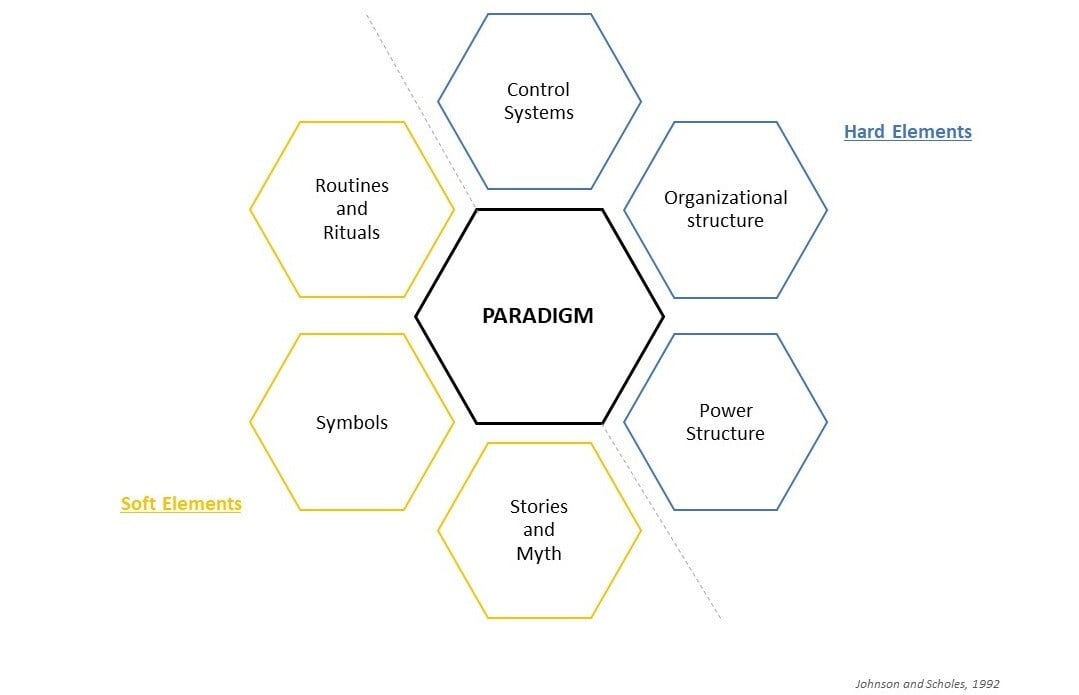Aligning your organization's culture with your strategy

HARD ELEMENTS[easy to change - Top Executive reality]
These elements revolve around the company’s structure and systems. This has to be looked at from a “Top-Down” perspective.
Control systems
These “Control systems elements” represent the business financial, reward and quality systems. These are the foundations for internal performance management including how good performances are encouraged and poor ones dealt with.
The questions management needs to ask when analyzing the control systems are:
· What processes are actually in place?
· Are these processes strongly are weakly controlled?
· Are the company controls rigid and tight or loose?
· Do employees get rewarded or penalized based on their performance?
· Are reports produced to keep control of operations and finances?
Organizational structure
Two essential influences can be identified: Written and Unwritten.
On one hand, written elements are directly linked to the organizational chart and is very clear to understand in terms of centralization (or decentralization) of power, who works at the company, who reports to whom and the final-decision makers.
On the other hand, unwritten influence is more indistinct and refers to the individuals with significant influence not reflected on the organizational chart.
The questions management needs to ask when analyzing the organizational structure are:
· How is the business structure? (Flat or hierarchical with several layers of management?
· Where are the formal lines of authority?
· Who are the influential employees?
Power structure
The power structure simply represents the dominant force in the company. In other words, those who dictates the strategy of the business and influence decisions.
The questions management needs to ask when analyzing the power structure are:
· Who has which specific type of power within the company? (Reward, Legitimate, Expert, Coercive or Referent)
· What do the employees defend within the organization?
· Is the power correctly used or abused?
SOFT ELEMENTS[hard to change – everyday reality]
These elements are part of the day to day life within the organization. These are more implied and ingrained into employees which makes it tough to modify.
Routines and Rituals
These elements represent the everyday reality of the “day at work” including acceptable and normalized behaviors and actions. These are also valued by management. These are the simple day to day habits that seem to have very little importance at first.
The questions management needs to ask when analyzing the routines and rituals are:
· What image/vision of the company do customers have?
· What do employees do on a day-to-day basis?
· What do employees expect from the company?
· What would be immediately noticeable if changed?
· What behavior do these routines embolden?
· How do employees react when an issue arise?
Symbols
Symbols are the employees and company branding. In other words, every visual and verbal representation of the business such as logo, branding, dress code which comes to mind when talking about the company. The business visual representation importance is growing constantly in a world full of constant flows of information.
The questions management needs to ask when analyzing the symbols are:
· Does the company uses a specific jargon?
· Are there any status symbols used within the organization?
· How is your organization generally viewed by non-customers?
Stories and myth
The stories and past events recalled influence the present and future behavior of new joiners and other employees. The stories being told inside the walls of the company symbolize the behaviors and paths to be followed by the employees. Some stories may be told but in fine, they should not be.
The questions management needs to ask when analyzing the stories and myth are:
· What stories do outsiders often tell about your organization?
· What is your business reputation among your customers and other stakeholders?
· What do these stories say about what your company’s believes in?
· What do employees talk about when they think of the history of the company?
· What stories are told to new joiners?
Once you’ve analyzed and understood your business culture, it is time to perform a culture mapping where a comparison is drawn between where the culture is and where you want it to be. Then, it is time to implement change (refer to article “The 8 Key steps for successfully leading change”) within your organization.